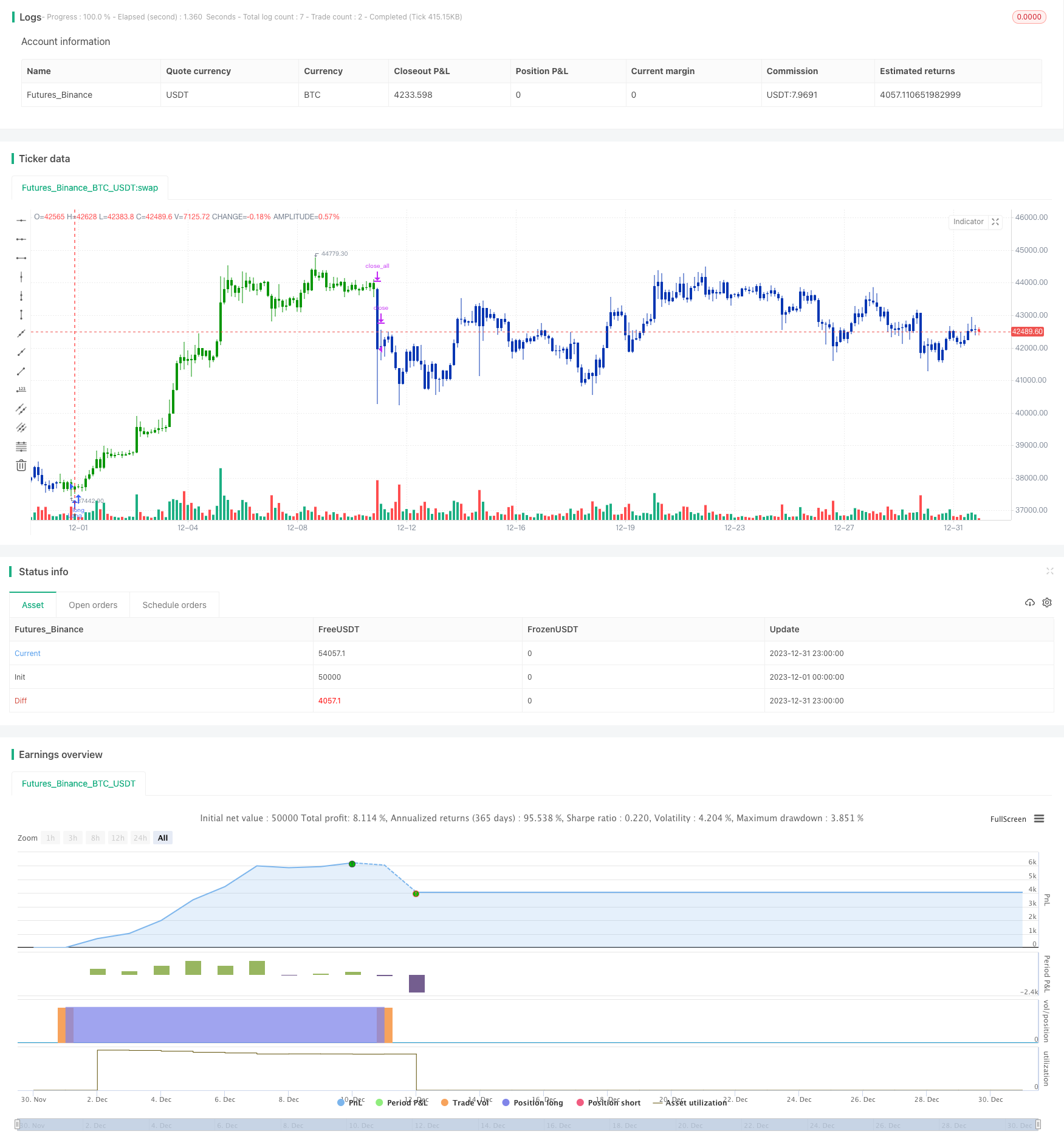
概述
该策略通过结合123反转策略和CMO均线策略,形成买卖信号的组合。123反转策略通过股票连续两天收盘价形成新的高点或低点,结合随机指标判断市场买卖力度,产生交易信号。CMO均线策略则利用CMO指标判断价格动量,产生交易信号。两种策略信号结合,可形成更可靠的组合信号。
策略原理
123反转策略运用以下原理产生交易信号:
- 当收盘价连续两天上涨,且9日随机指标低于50时,做多
- 当收盘价连续两天下跌,且9日随机指标高于50时,做空
该策略通过判断价格在短期内是否形成新的高点或低点,结合随机指标的多空指标,产生交易信号。
CMO均线策略运用以下原理产生交易信号:
- 计算5日、10日和20日的CMO值
- 求出其平均值
- 当平均CMO高于70时,做多
- 当平均CMO低于-70时,做空
该策略通过对不同周期CMO值的集合运算,判断价格动量指标的多空,产生交易信号。
组合策略对两个策略的信号进行AND运算,即两个策略的信号同时做多或同时做空时,该组合策略才产生实际的交易信号。
策略优势
该策略具有以下优势:
- 组合信号更加可靠,可减少虚假信号
- 123反转策略适合捕捉短期调整后的趋势
- CMO均线策略判断大级别价格动量
- 可适应不同市场环境
风险分析
该策略也存在以下风险:
- 123反转策略对价格的形态依赖较高,可能出现失效
- CMO指标对市场震荡敏感,可能产生错误信号
- 组合策略的信号可能过于保守,漏失交易机会
- 需要适当调整参数,使之适应不同周期和市场环境
对策有:
- 优化反转策略的形态判断规则
- 在CMO均线策略中加入其他辅助指标
- 评估最近一段时间的策略效果,动态调整参数
优化方向
该策略可从以下方面进行优化:
- 使用机器学习算法自动优化组合权重
- 增加自适应调参模块,使策略参数动态优化
- 增加止损模块,有效控制风险
- 评估策略健壮性,改进形态识别算法
- 结合行业选择、基本面等因素
总结
该策略通过123反转和CMO均线两种互补性强的策略,形成有效的组合交易策略。在控制风险的前提下,可产生稳定的超额收益。随着算法和模型的不断优化,期待该策略的收益率和稳定性获得进一步提高。
策略源码
/*backtest
start: 2023-12-01 00:00:00
end: 2023-12-31 23:59:59
period: 3h
basePeriod: 15m
exchanges: [{"eid":"Futures_Binance","currency":"BTC_USDT"}]
*/
//@version=4
////////////////////////////////////////////////////////////
// Copyright by HPotter v1.0 19/09/2019
// This is combo strategies for get a cumulative signal.
//
// First strategy
// This System was created from the Book "How I Tripled My Money In The
// Futures Market" by Ulf Jensen, Page 183. This is reverse type of strategies.
// The strategy buys at market, if close price is higher than the previous close
// during 2 days and the meaning of 9-days Stochastic Slow Oscillator is lower than 50.
// The strategy sells at market, if close price is lower than the previous close price
// during 2 days and the meaning of 9-days Stochastic Fast Oscillator is higher than 50.
//
// Second strategy
// This indicator plots average of three different length CMO's. This indicator
// was developed by Tushar Chande. A scientist, an inventor, and a respected
// trading system developer, Mr. Chande developed the CMO to capture what he
// calls "pure momentum". For more definitive information on the CMO and other
// indicators we recommend the book The New Technical Trader by Tushar Chande
// and Stanley Kroll.
// The CMO is closely related to, yet unique from, other momentum oriented
// indicators such as Relative Strength Index, Stochastic, Rate-of-Change, etc.
// It is most closely related to Welles Wilder?s RSI, yet it differs in several ways:
// - It uses data for both up days and down days in the numerator, thereby directly
// measuring momentum;
// - The calculations are applied on unsmoothed data. Therefore, short-term extreme
// movements in price are not hidden. Once calculated, smoothing can be applied to
// the CMO, if desired;
// - The scale is bounded between +100 and -100, thereby allowing you to clearly see
// changes in net momentum using the 0 level. The bounded scale also allows you to
// conveniently compare values across different securities.
//
// WARNING:
// - For purpose educate only
// - This script to change bars colors.
////////////////////////////////////////////////////////////
Reversal123(Length, KSmoothing, DLength, Level) =>
vFast = sma(stoch(close, high, low, Length), KSmoothing)
vSlow = sma(vFast, DLength)
pos = 0.0
pos := iff(close[2] < close[1] and close > close[1] and vFast < vSlow and vFast > Level, 1,
iff(close[2] > close[1] and close < close[1] and vFast > vSlow and vFast < Level, -1, nz(pos[1], 0)))
pos
CMOav(Length1,Length2,Length3, TopBand, LowBand) =>
pos = 0
xMom = close - close[1]
xMomabs = abs(close - close[1])
nSum1 = sum(xMom, Length1)
nSumAbs1 = sum(xMomabs, Length1)
nSum2 = sum(xMom, Length2)
nSumAbs2 = sum(xMomabs, Length2)
nSum3 = sum(xMom, Length3)
nSumAbs3 = sum(xMomabs, Length3)
nRes = 100 * (nSum1 / nSumAbs1 + nSum2 / nSumAbs2 + nSum3 / nSumAbs3 ) / 3
pos := iff(nRes > TopBand, 1,
iff(nRes < LowBand, -1, nz(pos[1], 0)))
pos
strategy(title="Combo Backtest 123 Reversal & CMOav", shorttitle="Combo", overlay = true)
Length = input(14, minval=1)
KSmoothing = input(1, minval=1)
DLength = input(3, minval=1)
Level = input(50, minval=1)
//-------------------------
Length1 = input(5, minval=1)
Length2 = input(10, minval=1)
Length3 = input(20, minval=1)
TopBand = input(70, minval=1)
LowBand = input(-70, maxval=-1)
reverse = input(false, title="Trade reverse")
posReversal123 = Reversal123(Length, KSmoothing, DLength, Level)
posCMOav = CMOav(Length1,Length2,Length3, TopBand, LowBand)
pos = iff(posReversal123 == 1 and posCMOav == 1 , 1,
iff(posReversal123 == -1 and posCMOav == -1, -1, 0))
possig = iff(reverse and pos == 1, -1,
iff(reverse and pos == -1 , 1, pos))
if (possig == 1)
strategy.entry("Long", strategy.long)
if (possig == -1)
strategy.entry("Short", strategy.short)
if (possig == 0)
strategy.close_all()
barcolor(possig == -1 ? #b50404: possig == 1 ? #079605 : #0536b3 )